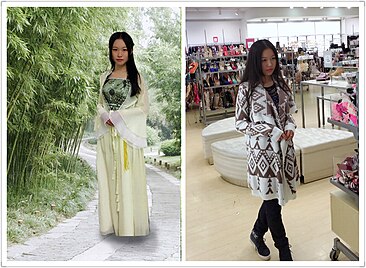
Back العولمة والمرأة في الصين Arabic Mujeres y globalización en China Spanish Globalisasi dan wanita di Tiongkok ID گلوبلائزیشن تے چین وچ خواتین PNB Impacto da globalização sobre as mulheres na China Portuguese ගෝලීයකරණය සහ චීනයේ කාන්තාවන් Singhalese گلوبلائزیشن اور چین میں خواتین Urdu 全球化与中国女性 Chinese

The study of the impact of globalization on women in China examines the role and status of Chinese women relative to the political and cultural changes that have taken place in the 20th century as a consequence of globalization. Globalization refers to the interaction and integration of people, products, cultures and governments between various nations around the globe; this is fostered by trade, investment, and information technology.[1][2] Globalization affected women's rights and the gender hierarchy in China, in aspects of domestic life such as marriage and primogeniture, as well as in the workplace. These changes altered the quality of life and the availability of opportunities to women at different junctures throughout the modern globalization process.
The dynamics of gender inequity are related with the ideological principles held by the ruling political regime. The imperial era was dominated by the social paradigm of Confucianism, which was a pervasive philosophy throughout the Orient. Confucian ideals emphasized morality, character, social relationship, and the status quo.[3] Confucius preached jen (humanity) and the equality and educability of all people;[4] Neo-Confucianists and Imperial leaders used his beliefs in social hierarchy, particularly in the family setting, for the physical and social oppression of women. As the Chinese government began to re-assimilate themselves into the global community in the late 19th to early 20th century, it shifted away from conventional Confucian ideals and women's role in society changed as well. After Mao Zedong established the People's Republic of China in 1949, a change in traditional gender roles came about. Mao's death marked the beginning of the current communist administration, and an influx of international communications in the areas of commerce, politics and social ideals.[5] Since the 1980s, under the new communist party, the women's rights movement has gained momentum and has become a national issue as well as a sign of modernization. Some reporters state that increased globalization and the Belt and Road Initiative have led to an increase in sex trafficking of women in China.[6]
In rural areas, women traditionally work alongside their family to produce crops like tea and rice. In urban areas, women work in factories, living away from home. Most of these factory workers are young girls who send their income to their families. To help maintain the rights of women in factories, labor unions and organizations were built. In their homes, women take care of their children and cook.
- ^ Jiang, Shiwei. "Global Trade and Its Effects on China's Female Labor Market." In International Studies Association (ISA) Annual Convention, San Francisco, CA. 2013.
- ^ Carnegie Endowment for the International Peace. (2009). What is Globalization?. Retrieved November 26, 2009. Retrieved from www.globalization101.org/What_is_Globalization.html.
- ^ Main Concepts of Confucianism. (n.d.). Retrieved November 28, 2009. Retrieved from http://philosophy.lander.edu/oriental/main.html.
- ^ Ng, R.M. (2009). College and character: What did Confucius Teach Us About the Importance of Integrating Ethics, Character, Learning, and Education? Journal of College & Character, vol 10(4), pp 1-7.
- ^ Sung, Y. W. (1991). The China- Hong Kong Connection: The Key to China's Open Door Policy. pp. 1-183. New York: Cambridge University Press. ISBN 0-521-38245-9
- ^ "Bride trafficking, a problem on China's belt and road". South China Morning Post. 15 February 2020.
© MMXXIII Rich X Search. We shall prevail. All rights reserved. Rich X Search